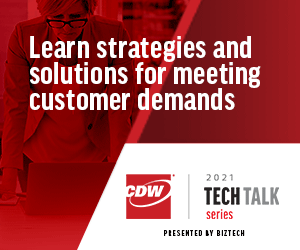The Pandemic Forced Companies Into Quick IT Decisions
During the pandemic, many organizations had to accelerate their technology decision-making because they needed to accommodate remote work. Graver pointed out some of the common choices made by companies and the lingering results of those decisions.
“Cloud adoption increased quite a bit, right? Cloud roadmaps accelerated across most companies. And this is partially driven by the need for holding onto staff or cash, in some scenarios,” he said. “But also the flexibility that this cloud provides — we’re able to spin up workloads and wind out workloads as needed and pay as you go. And now, for those who rushed into the cloud, they’re looking at costs. And, beyond costs, configuration, setups, development patterns, they’re now rethinking and fine-tuning cloud positions and really avoiding cloud lock at all times.”
“When COVID-19 hit, we all had to scramble, especially those in traditional infrastructures,” Graver continued. He observed that CDW customers with flexibility were able to adapt quickly, “versus those customers with classic, rigid, separate compute storage network architectures, where they were really left scrambling, versus perhaps a hyperconverged HCI environment, a more flexible, hyperconverged infrastructure that was easy to scale and manage. And, taking flexibility a little bit further beyond on-prem, HCI customers with true hybrid environments could shift, pivot really quickly and account for the massive change that happened overnight.”
“Another area where we saw an explosion was Desktop as a Service. And, for those companies that were already in this area, they really had a massive head start in the first few weeks. They were able to quickly accommodate that remote workforce,” he said. “But beyond cloud and HCI and desktop, our customers with a high degree of digital transformation maturity did very well. And that’s the consistent theme that I saw throughout this entire pandemic.”
Companies Are Continuing to Invest in Remote Work Solutions
As the pandemic has stretched on and companies have extended remote and hybrid work policies, many of them have had to revisit their IT needs. “The question now is, how will we operate post-pandemic? First, where are we going to work? We’re expecting a return to the office, right? But for knowledge workers, we see this really more in a part-time capacity, versus a full-time return to a physical office, in most cases,” Graver said.
With companies that are returning to the office, Graver has noticed some trends. “We've seen some businesses quickly implement new office designs. Lots of hoteling space for many offices, with reservation systems. We’re being forced to rethink visitor management systems, conference rooms, office gatherings, etc. Offices are really less of a place to work and more of a place to collaborate. That’s what we’re seeing.”
Graver recommended leaning into new ideas and not accepting the norm. “We're more productive now than we’ve ever been. I see companies now rethinking KPIs, the way they measure work output. We’re seeing the emergence of new tools that companies are embracing now to support this new way of measuring work. So a lot of challenges that we’ll face but basically, we want technology to work for us.”
A Dynamic Infrastructure Demands Reliable Data
NetApp’s Matt Brown, executive director of IT customer engagement, and Stephan Stelter, national technical partner manager, also joined the conversation to offer their insights on how IT infrastructure can drive new and better business outcomes.
“If you really want to talk about dynamic infrastructure, to me, what it means is from the network all the way up, the ability to provide utilitylike availability. And then operations to be able to scale up and scale down to business cycles,” Brown said. “And, in terms of delivery to the developers, on-demand delivery, where we can deliver the entire development stacks — ideally, as fast as possible, to really allow the developers to be as productive as possible.”
Stelter offered his definition of a dynamic infrastructure, which he said is probably different for every organization. “There’s different interpretations of how companies want to take the next step in their IT infrastructure, how they want to become flexible and take advantage of the instant availability of things like cloud architectures. So there are pieces of optimizing your on-premises infrastructure that really lend themselves to being able to leverage next-generation cloud technologies.”
While virtualization helped customers seeking to become more dynamic, it was “one of those areas where you try to centralize some storage and try to build yourself to a common data set and carve that up and have the applications access that data set. So you’re managing an infrastructure that is a bit more flexible in that regard,” Stelter said.
Brown pointed out the need for organizations to develop a single data set. “As you know, there’s a difference between data sets and the data that you’re managing holistically across the environment. And part of the goal there is, No. 1, we don’t want to make multiple copies of our data. So really being cognizant of what applications, what capabilities are using data, and establishing those single sources of truth, and then ensuring that we’re providing the proper governance around them.”












